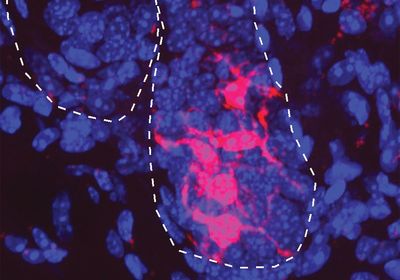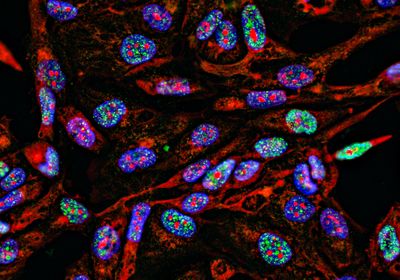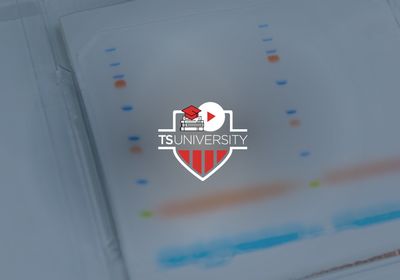ABOVE: Melanocyte stem cells develop dendritic-cell appearance when they differentiate. Melanocyte stem cells are shown in red and other cell nuclei are shown in blue. Qi Sun
Like human aging, stem cell maturation is considered a one-way process; once an undifferentiated stem cell goes down the path to become a specific type of cell, there is no turning back. But that does not seem to be the case with melanocyte stem cells (McSC), which give rise to cells that produce hair and skin pigments.
In a recent study, researchers from New York University (NYU) investigated McSC in hair follicles and found that depending on microenvironment cues, McSCs can fluctuate between undifferentiated and differentiated states. The researchers also found that as the hair follicle ages, a larger number of melanocyte stem cells get stuck in an undifferentiated state, losing their ability to mature and produce melanin.1 Published in Nature, these results not only challenge the traditional view on how stem cells differentiate, but also offer clues to why hair turns gray with aging.
“When we started the study, we thought that melanocyte stem cells may follow the classical stem cell model,” said Qi Sun, a postdoctoral researcher at NYU who coauthored the research. According to this model, some of the stem cells remain undifferentiated to replenish the stem cell pool, while others differentiate into progenitors that eventually transform into mature cells that produce melanin.
Sun and her colleagues, led by Mayumi Ito, a stem cell biologist at NYU, wanted to test if McSC behave like other stem cell populations. The team used mice genetically engineered with fluorescence-reporter-expressing McSC and revisited the same hair follicles over time to track the locations of these cells. The team evaluated cell morphology and expression of differentiation markers (pigmentation genes) as indicators of cell maturity states as hair follicles completed their growth and shed cycles.
The researchers were surprised to find that McSC did not reside in an area called the bulge as previously thought, but were instead located in a compartment known as the hair germ. When the hair started to grow, the McSC transitioned to an intermediate differentiation state from which they either transformed into fully mature melanocytes at the base of the growing hair or moved up to the hair bulge where they stayed as undifferentiated cells. Then these stem cells homed back to the hair germ as the hair entered the resting phase of its growth cycle.
Once they realized that the maturation of these cells depended on their location, the team next investigated which signals within those compartments drove these changes. Ito’s team had previously reported that Wnt signaling is essential for McSC differentiation.2 In the new study, the team found that nearby epithelial cells in the hair germ released Wnt ligands that mature the McSC, but these signals were suppressed in the bulge where the cells regained their undifferentiated features.
Melanocytes give hair its color, and hair pigmentation reduces with aging. So, the researchers wondered what would happen to McSC mobility in an aged hair follicle. To accelerate the aging of hair follicles, the team plucked mouse hair to induce regeneration of the follicles and observed McSCs over time. “In aged mice, we found more of the stem cells in the bulge area rather than going back to the hair germ,” said Sun.
These findings suggested that as the hair follicle ages, McSC get stuck in a region where less pigment-inducing signals are present. This mechanism might explain why hair turns gray much more rapidly than it falls off, said Rui Yi, a stem cell biologist at Northwestern University, who was not involved in the research.
Although scientists knew that cells could swing back and forth between their maturity states when there were tissue injuries, the study results are exciting as they reveal that dedifferentiation can also occur under a physiological condition, said George Cotsarelis, a dermatologist at the University of Pennsylvania who was also not involved in the study.
Since the researchers conducted all of the experiments in mice, questions remain as to whether the same events are also seen in humans, said Yi. “Future work needs to be done to really show whether this failure, for example, to dedifferentiate by melanocyte cells is a major cause of the loss of melanocyte stem cells or loss of the hair color over time.”
References
- Sun Q, et al. Dedifferentiation maintains melanocyte stem cells in a dynamic niche. Nature. 2023;616(7958):774-782.
- Rabbani P, et al. Coordinated activation of Wnt in epithelial and melanocyte stem cells initiates pigmented hair regeneration. Cell. 2011;145(6):941-955.







